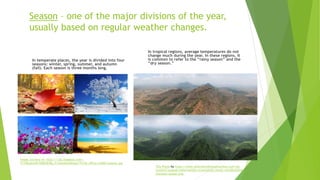This is why we have seasons
- 1. Vocabulary Seasons: Why do we have them? Earth and Environmental Science For NCVPS Kella Randolph, M. Ed https://images-wixmp-ed30a86b8c4ca887773594c2.wixmp.com/f/1541e07c-429c-4990-ab84- 850d933a59e4/d2gubv4-5758f426-25ec-4669-8c59- 3017484d9d5b.jpg/v1/fill/w_900,h_633,q_75,strp/four_seasons_by_nalmes.jpg?token=eyJ0eXAiOiJKV1Qi LCJhbGciOiJIUzI1NiJ9.eyJpc3MiOiJ1cm46YXBwOjdlMGQxODg5ODIyNjQzNzNhNWYwZDQxNWVhMGQyNmUwI iwic3ViIjoidXJuOmFwcDo3ZTBkMTg4OTgyMjY0MzczYTVmMGQ0MTVlYTBkMjZlMCIsImF1ZCI6WyJ1cm46c2Vy dmljZTppbWFnZS5vcGVyYXRpb25zIl0sIm9iaiI6W1t7InBhdGgiOiIvZi8xNTQxZTA3Yy00MjljLTQ5OTAtYWI4NC0 4NTBkOTMzYTU5ZTQvZDJndWJ2NC01NzU4ZjQyNi0yNWVjLTQ2NjktOGM1OS0zMDE3NDg0ZDlkNWIuanBnIiwid 2lkdGgiOiI8PTkwMCIsImhlaWdodCI6Ijw9NjMzIn1dXX0.8TQef5W_FlK7bG3Znv0WenPae-l-7N1MN_dg0DZa0So
- 3. Direct sunlight – sunlight that strikes Earth’s surface at close to a 90° angle. Image courtesy of: 324x400-icp.giss.nasa.gov
- 4. Earth’s axis – an imaginary line through the center of Earth that connects the North Pole to the South Pole. Image courtesy of: clasfaculty.ucdenver.edu1601 × 1135 Earth rotates about its axis once every 24 hours. Earth’s axis is tilted at an angle of 23.5 degrees.
- 5. Equator Image courtesy of: scijinks.jpl.nasa.gov800 × 597 an imaginary horizontal line around the middle of Earth.
- 6. Northern hemisphere – the half of Earth north of the equator. Image courtesy of: www.astronomy.org570 × 320
- 7. Hemispheres Image courtesy of: urbanext.illinois.edu900 × 600
- 8. North Pole – the northernmost point on Earth. Image courtesy of: Earthobservatory.nasa.gov1280 × 720
- 9. Indirect sunlight – sunlight that strikes Earth’s surface at an acute angle (less than 90˚). Image courtesy of: http://scijinks.jpl.nasa.gov/solstice
- 10. Season – one of the major divisions of the year, usually based on regular weather changes. In temperate places, the year is divided into four seasons: winter, spring, summer, and autumn (fall). Each season is three months long. In tropical regions, average temperatures do not change much during the year. In these regions, it is common to refer to the “rainy season” and the “dry season.” Image courtesy of: http://1.bp.blogspot.com/- V1748xphwI8/UMRn83Bq_fI/AAAAAAAAAgw/TtrGR_sW5js/s1600/seasons.jpg This Photo by https://www.otherworldlyincantations.com/wp- content/uploads/otherworldly-incantations-forest-worldbuilding- monsoon-season.png
- 11. Southern hemisphere – the half of Earth south of the equator. This photo courtesy of: http://urbanext.illinois.edu/treehouse/seasons.cfm?Slide=6
- 12. South Pole – the southernmost point on Earth. This photo courtesy of: science.dodlive.mil330 × 317
- 13. Summer solstice – the first day of summer. The summer solstice is the longest day of the year. North and south of the tropics, it is also the day when the noon Sun is highest in the sky. In the northern hemisphere the summer solstice occurs on or near June 21. In the southern hemisphere the summer solstice occurs on or near December 21. This photo courtesy of: Solarsystem.nasa.gov732x520
- 14. Winter solstice – the first day of winter. This photo courtesy of: spacescience.arc.nasa.gov860 × 389 The winter solstice is the shortest day of the year. It is also the day when the noon Sun is lowest in the sky. In the northern hemisphere the winter solstice occurs on or near December 21. In the southern hemisphere the winter solstice occurs on or near June 21.
- 15. That is why do we have seasons. NCVPS Kella Randolph M.Ed.















